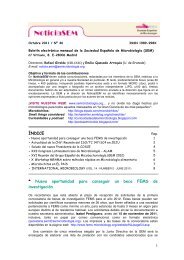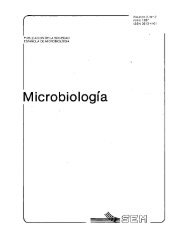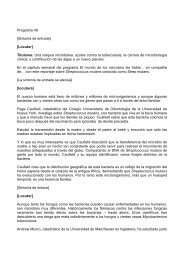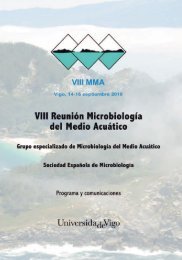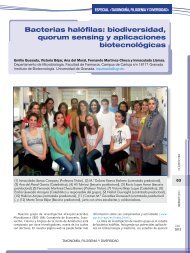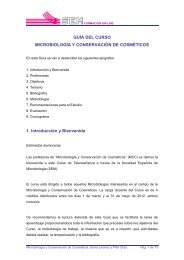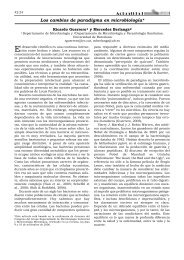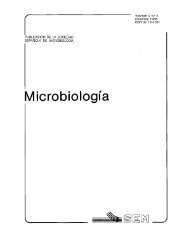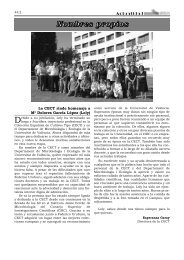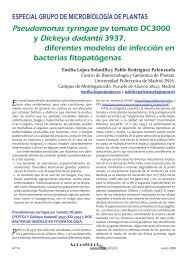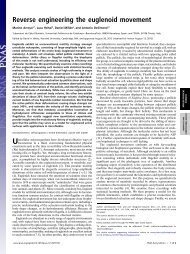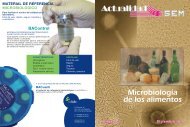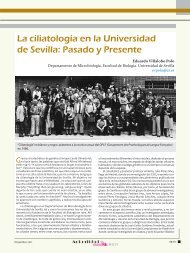Vol. 4 núm. 2 y 3 - Sociedad Española de MicrobiologÃa
Vol. 4 núm. 2 y 3 - Sociedad Española de MicrobiologÃa
Vol. 4 núm. 2 y 3 - Sociedad Española de MicrobiologÃa
You also want an ePaper? Increase the reach of your titles
YUMPU automatically turns print PDFs into web optimized ePapers that Google loves.
100 RAFAEL IBÁÑEZ Y GABRIEL MEGÍAS<br />
se han mostrado sinérgicas frente al H. pertussis y B. abortus, especialmente<br />
cuando se combinan en ciertas proporciones.<br />
5) Se sugiere ía posibilidad <strong>de</strong> que los antihistamínicos, y especialmente<br />
el AH,, <strong>de</strong> baja toxicidad y notables propieda<strong>de</strong>s bactericidas, asociado o los<br />
quimioterápicos, disminuya o anule efectos secundarios^ <strong>de</strong> ciertos antibióticos,<br />
así como las reacciones <strong>de</strong> tipo alérgico, fenómenos todos que, en sentido amplio,<br />
pue<strong>de</strong>n interpretarse como reacciones <strong>de</strong>l organismo inducidas por substancias<br />
proce<strong>de</strong>ntes, al menos en gran parte, <strong>de</strong> los gérmenes invasores.<br />
6} Se hace notar, como resultado <strong>de</strong> nuestra experiencia y <strong>de</strong> la <strong>de</strong> otros<br />
autores que, una vez <strong>de</strong>cidido eí empleo en el tratamiento <strong>de</strong> combinaciones <strong>de</strong><br />
antibióticos, quimioterápicos o <strong>de</strong> ambos, es indispensable la utilización <strong>de</strong><br />
mezclas, cuya composición cualitativa y cuantitativa haya sido estudiada previamente<br />
y consi<strong>de</strong>rada óptima <strong>de</strong>s<strong>de</strong> el punto <strong>de</strong> vista experimental y clínico,<br />
constituyendo en sí estas combinaciones entida<strong>de</strong>s terapéuticas <strong>de</strong> propieda<strong>de</strong>s<br />
fijas, conocidas y controlables, siendo con<strong>de</strong>nable, en términos generales, el uso<br />
<strong>de</strong> tratamientos combinados instituidos arbitrariamente en su composición y administración,<br />
con los que, en lugar <strong>de</strong> la suma <strong>de</strong> efectos o <strong>de</strong> la sinergia pretendidas,<br />
pue<strong>de</strong>n obtenerse resultados antagónicos.<br />
BIBLIOGRAFÍA<br />
(1) BIGGER, J. W. 1946. Lancet. 250: 81.<br />
(2) THOMAS, J. C. y HAYES, W. 1947. J. Hyg. 45: 313.<br />
(3) COAA^\ERFORD, C. H. et alter. 1946. Lancet. 251: 81.<br />
(4) MASSEL, B. F. et alter. 1946. J. Bact. 52: 33.<br />
(5) STEWART, G. T. 1947. J. Hyg. 45: 282.<br />
(Ó) FOLEY, E. J. 1948. J. Immunol. 58: 203.<br />
(7) DESPOIS, R. y PINNET, S. 1950. C. R. Soc. Biol. 114: 23.<br />
(8) NICHOLS, A. 1949. Proc. Soc. Exp. Biol. Med. 69: 477.<br />
(9) EDITORIAL. 1950. J. A. M. A. 143: 816.<br />
(10) PULASKI, E. J. y BAKER, H. J. 1949. J. Clin. Med. 34: 186.<br />
(11) PULASKI, E. J. y AMSPACHER, W. H. 1947. Bull. U. S. Army Med.<br />
Dep. 7: 21 L<br />
(12) EISELE, C. W. y MC. CULLOUGHT, N. B. 1947. J. A. M. A. 135: 1.053.<br />
(13) SPINK, W. E. et alter. 1948. J. A. M. A. 136: 382.<br />
(14) HERRELL W. E. y BARBER, T. E. 1949. Proc. Staff. Meet. Mayo. Clin.<br />
24: 138.<br />
(15) HERRELL, W. E. et alter. 1950. Ibid. 25: 185.<br />
(16) HEILMAN, F. R. 1949. Proc. Staff.,Meet. Mayo. Clin. 24: 133.<br />
(17) WERNER, C. A. y KNIGHT, V. I. 1950. J. Immunol. 65: 509.<br />
(18) EAGLE, H. y FLEISCHMAN, R. 1948. Proc. Exp. Biol. Med. 68: 415.




